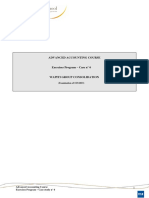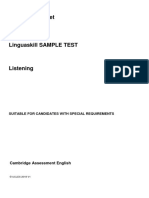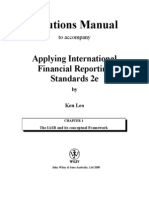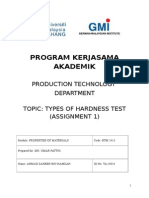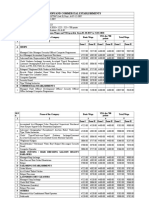cd8cd552db28943f022096d821b9a279 (1)
cd8cd552db28943f022096d821b9a279 (1)
Uploaded by
Azri LunduCopyright:
Available Formats
cd8cd552db28943f022096d821b9a279 (1)
cd8cd552db28943f022096d821b9a279 (1)
Uploaded by
Azri LunduOriginal Description:
Copyright
Available Formats
Share this document
Did you find this document useful?
Is this content inappropriate?
Copyright:
Available Formats
cd8cd552db28943f022096d821b9a279 (1)
cd8cd552db28943f022096d821b9a279 (1)
Uploaded by
Azri LunduCopyright:
Available Formats
182
Test Bank for International Economics, 9e
CHAPTER 11
THE BALANCE OF PAYMENTS
MULTIPLE-CHOICE QUESTIONS
1. On the balance-of-payments statements, merchandise imports are classified in the:
a.
Current account
b.
Capital account
c.
Unilateral transfer account
d.
Official settlements account
2. The balance of international indebtedness is a record of a countrys international:
a.
Investment position over a period of time
b.
Investment position at a fixed point in time
c.
Trade position over a period of time
d.
Trade position at a fixed point in time
3. Which balance-of-payments item does not directly enter into the calculation of the U.S. gross domestic
product?
a.
Merchandise imports
b.
Shipping and transportation receipts
c.
Direct foreign investment
d.
Service exports
4. Which of the following is considered a capital inflow?
a.
A sale of U.S. financial assets to a foreign buyer
b.
A loan from a U.S. bank to a foreign borrower
c.
A purchase of foreign financial assets by a U.S. buyer
d.
A U.S. citizens repayment of a loan from a foreign bank
5. Which of the following would call for inpayments to the United States?
a.
American imports of German steel
b.
Gold flowing out of the United States
c.
American unilateral transfers to less-developed countries
d.
American firms selling insurance to British shipping companies
183
Test Bank for International Economics, 9e
6. In a countrys balance of payments, which of the following transactions are debits?
a.
Domestic bank balances owned by foreigners are decreased
b.
Foreign bank balances owned by domestic residents are decreased
c.
Assets owned by domestic residents are sold to nonresidents
d.
Securities are sold by domestic residents to nonresidents
7. Which of the following is classified as a credit in the U.S. balance of payments?
a.
U.S. exports
b.
U.S. gifts to other countries
c.
A flow of gold out of the U.S.
d.
Foreign loans made by U.S. companies
Table 11.1 gives hypothetical figures for U.S. International Transactions. On the basis of this information, answer
Questions 8 and 9.
Table 11.1.U.S. International Transactions
Transaction
Amount
(billions of dollars)
Merchandise imports
Military transactions, net
Remittances, pensions, transfers
U.S. private assets abroad
Merchandise exports
Investment income, net
U.S. government grants(excluding military)
Foreign private assets in the U.S.
Compensation of employees
Allocation of SDRs
Travel and transportation receipts, net
110
5
20
50
115
15
5
25
5
5
20
8. Based on the information provided in Table 11.1, the goods and services balance equals:
a.
$5 billion
b.
$15 billion
c.
$20 billion
d.
$25 billion
9. Based on the information provided in Table 11.1, the current account balance equals:
a.
$5 billion
b.
$10 billion
c.
$15 billion
d.
$20 billion
Chapter 11:The Balance of Payments
184
10. Unlike the balance of payments, the balance of international indebtedness indicates the international:
a.
Investment position of a country at a given moment in time
b.
Investment position of a country over a one-year period
c.
Trade position of a country at a given moment in time
d.
Trade position of a country over a one-year period
11. Which of the following indicates the international investment position of a country at a given moment in
time?
a.
The balance of payments
b.
The capital account of the balance of payments
c.
The current account of the balance of payments
d.
The balance of international indebtedness
12. Concerning the U.S. balance of payments, which account is defined in essentially the same way as the net
export of goods and services, which comprises part of the countrys gross domestic product?
a.
Merchandise trade account
b.
Goods and services account
c.
Current account
d.
Capital account
13. If an American receives dividends from the shares of stock she or he owns in Toyota, Inc., a Japanese firm,
the transaction would be recorded on the U.S. balance of payments as a:
a.
Capital account debit
b.
Capital account credit
c.
Current account debit
d.
Current account credit
14. If the United States government sells military hardware to Saudi Arabia, the transaction would be recorded
on the U.S. balance of payments as a:
a.
Current account debit
b.
Current account credit
c.
Capital account debit
d.
Capital account credit
15. The U.S. balance of trade is determined by:
a.
Exchange rates
b.
Growth of economies overseas
c.
Relative prices in world markets
d.
All of the above
16. U.S. military aid granted to foreign countries is entered in the:
a.
Merchandise trade account
b.
Capital account
c.
Current account
d.
Official settlements account
185
Test Bank for International Economics, 9e
17. If the U.S. faces a balance-of-payments deficit on the current account, it must run a surplus on:
a.
The official settlements account
b.
The capital account
c.
Either the official settlements account or the capital account
d.
Both the official settlements account and the capital account
18. The current account of the U.S. balance of payments does not include:
a.
Investment income
b.
Merchandise exports and imports
c.
The sale of securities to foreigners
d.
Unilateral transfers
19. The U.S. has a balance of trade deficit when its:
a.
Merchandise exports exceed its merchandise imports
b.
Merchandise imports exceed its merchandise exports
c.
Goods and services exports exceed its goods and services imports
d.
Goods and services imports exceed its goods and services exports
20. The value to American residents of income earned from overseas investments shows up in which account in
the U.S. balance of payments?
a.
Current account
b.
Trade account
c.
Unilateral transfers account
d.
Capital account
Using the data of Table 11.2, answer Question 21.
Table 11.2.International Investment Position of the United States
U.S. assets abroad
U.S. government assets
U.S. private assets
$800 billion
$200 billion
Foreign assets in the U.S.
Foreign official assets
Foreign private assets
$600 billion
$300 billion
21. Consider Table 11.2. The U.S. balance of international indebtedness suggests that the United States is a net:
a.
Debtor
b.
Creditor
c.
Spender
d.
Exporter
Chapter 11:The Balance of Payments
22. For the first time since World War I, in 1985 the United States became a net international:
a.
Exporter
b.
Importer
c.
Debtor
d.
Creditor
23. A country that is a net international debtor initially experiences:
a.
An augmented savings pool available to finance domestic spending
b.
A higher interest rate, which leads to lower domestic investment
c.
A loss of funds to trading partners overseas
d.
A decrease in its services exports to other countries
24. Credit (+) items in the balance of payments correspond to anything that:
a.
Involves receipts from foreigners
b.
Involves payments to foreigners
c.
Decreases the domestic money supply
d.
Increases the demand for foreign exchange
25. Debt () items in the balance of payments correspond to anything that:
a.
Involves receipts from foreigners
b.
Involves payments to foreigners
c.
Increases the domestic money supply
d.
Decreases the demand for foreign exchange
26. When all of the debit or credit items in the balance of payments are combined:
a.
Merchandise imports equal merchandise exports
b.
Capital imports equal capital exports
c.
Services exports equal services imports
d.
The total surplus or deficit equals zero
27. In the balance of payments, the statistical discrepancy is used to:
a.
Ensure that the sum of all debits matches the sum of all credits
b.
Ensure that trade imports equal the value of trade exports
c.
Obtain an accurate account of a balance-of-payments deficit
d.
Obtain an accurate account of a balance-of-payments surplus
28. All of the following are credit items in the balance of payments, except:
a.
Investment inflows
b.
Merchandise exports
c.
Payments for American services to foreigners
d.
Private gifts to foreign residents
29. All of the following are debit items in the balance of payments, except:
a.
Capital outflows
b.
Merchandise exports
c.
Private gifts to foreigners
d.
Foreign aid granted to other nations
186
187
Test Bank for International Economics, 9e
30. The role of __________ is to direct one nations savings into another nations investments.
a.
Merchandise trade flows
b.
Services flows
c.
Current account flows
d.
Capital flows
31. When a country realizes a deficit on its current account:
a.
Its net foreign investment position becomes positive
b.
It becomes a net demander of funds from other countries
c.
It realizes an excess of imports over exports on goods and services
d.
It becomes a net supplier of funds to other countries
32. Reducing a current account deficit requires a country to:
a.
Increase private saving relative to investment
b.
Increase private consumption relative to saving
c.
Increase private investment relative to consumption
d.
Increase private investment relative to saving
33. Reducing a current account deficit requires a country to:
a.
Increase the governments deficit and increase private investment relative to saving
b.
Increase the governments deficit and decrease private investment relative to saving
c.
Decrease the governments deficit increase private investment relative to saving
d.
Decrease the governments deficit and decrease private investment relative to saving
34. Reducing a current account surplus requires a country to:
a.
Increase the governments deficit and increase private investment relative to saving
b.
Increase the governments deficit and decrease private investment relative to saving
c.
Decrease the governments deficit and increase private investment relative to saving
d.
Decrease the governments deficit and decrease private investment relative to saving
35. Concerning a countrys business cycle, rapid growth of production and employment is commonly
associated with:
a.
Large or growing trade deficits and current account deficits
b.
Large or growing trade deficits and current account surpluses
c.
Small or shrinking trade deficits and current account deficits
d.
Small or shrinking trade deficits and current account surpluses
36. The burden of a current account deficit would be the least if a nation uses what it borrows to finance:
a.
Unemployment compensation benefits
b.
Social Security benefits
c.
Expenditures on food and recreation
d.
Investment on plant and equipment
188
Chapter 11:The Balance of Payments
37. Concerning a countrys business cycle, __________ is commonly associated with large or growing current
account deficits:
a.
Rapid growth rates of production and employment
b.
Slow growth rates of production and employment
c.
Falling interest rates on government securities
d.
Falling interest rates on corporate securities
38. According to researchers at the Federal Reserve, the loss of jobs associated with a deficit in the current
account tends to be:
a.
Offset by the increase of jobs associated with a surplus in the capital account
b.
Reinforced by the decrease of jobs associated with a surplus in the capital account
c.
A threat to the level of employment for the economy as a whole
d.
Of no long-run economic consequence for workers who lose their jobs
TRUE-FALSE QUESTIONS
Table 11.3 shows hypothetical transactions, in billions of U.S. dollars, that took place during a year. Answer the
next seven questions on the basis of this information.
Table 11.3.International Transactions of the United States
Transaction
Amount
(billions of dollars)
Allocation of SDRs
Changes in U.S. assets abroad
Statistical discrepancy
Merchandise imports
Payments on foreign assets in U.S.
Remittances, pensions, transfers
Travel and transportation receipts, net
Military transactions, net
Investment income, net
Merchandise exports
U.S. government grants(excluding military)
Changes in foreign assets in the U.S.
Other services, net
Receipts on U.S. investments abroad
Compensation of employees
10
100
15
400
20
60
30
10
100
350
20
190
80
30
10
1. Consider Table 11.3. The merchandise-trade balance registered a deficit of $50 billion.
2. Consider Table 11.3. The services balance registered a surplus of $100 billion.
189
Test Bank for International Economics, 9e
3. Consider Table 11.3. The goods-and-services balance registered a surplus of $50 billion.
4. Consider Table 11.3. The unilateral-transfers balance registered a deficit of $40 billion.
5. Consider Table 11.3. The current-account balance registered a surplus of $30 billion.
6. Consider Table 11.3. The net exports component of the U.S. gross domestic product
registered $110 billion.
7. Consider Table 11.3. The payments data suggest that the United States was a net demander of
$30 billion from the rest of the world.
8. The balance of payments refers to the stock of trade and investment transactions that exists at a
particular point in time.
9. Referring to the balance-of-payments statement, an international transaction refers to the
exchange of goods, services, and assets between residents of one country and those abroad.
10. The balance of payments includes international transactions of households and businesses, but
not government.
11. Because the balance of payments utilizes double-entry accounting, merchandise exports will
always be in balance with merchandise imports.
12. On the U.S. balance-of-payments statement, the following transactions are credits, leading to
the receipt of dollars from foreigners: merchandise exports, transportation receipts, income
received from investments abroad, and investments in the United States by foreign residents.
13. On the U.S. balance of payments, the following transactions are debits, leading to payments to
foreigners: merchandise imports, travel expenditures, gifts to foreign residents, and overseas
investments by U.S. residents.
14. The goods and services account of the balance of payments shows the monetary value of
international flows associated with transactions in goods, services, and unilateral transfers.
15. An increase in import restrictions by the U.S. government tends to promote a merchandisetrade surplus.
16. Services transactions on Canadas balance-of-payments statement would include Canadian
ships transporting lumber to Japan, foreign tourists spending money in Canada, and Canadian
engineers designing bridges in China.
17. On the balance-of-payments statement, dividend and interest income are classified as capitalaccount transactions.
18. A surplus on Germanys goods-and-services balance indicates that Germany has sold more
goods and services to foreigners than it has bought from them over a one-year period.
Chapter 11:The Balance of Payments
190
19. The merchandise-trade account on the balance-of-payments statement is defined the same way
as net exports which constitutes part of the nations gross domestic product.
20. A positive balance on the goods-and-services account of the balance of payments indicates an
excess of exports over imports which must be added to the nations gross domestic product.
21. For the United States, merchandise trade has generally constituted the largest portion of its
goods-and-services account.
22. Unilateral transfers refer to two-sided transactions, reflecting the movement of goods and
services in one direction with corresponding payments in the other direction.
23. Unilateral transfers consist of private-sector transfers, such as church contributions to alleviate
starvation in Africa, as well as governmental transfers, such as foreign aid.
24. Current-account transactions include direct foreign investment, purchases of foreign
government securities, and commercial bank loans made abroad.
25. On the U.S. balance-of-payments statement, a capital inflow would occur if a Swiss resident
purchases the securities of the U.S. government.
26. If Toyota Inc. of Japan builds an automobile assembly plant in the United States, the Japanese
capital account would register an outflow.
27. If Bank of America receives repayment for a loan it made to a Mexican firm, the U.S. capital
account would register an inflow.
28. On the balance-of-payments statement, a capital inflow can be likened to the import of goods
and services.
29. The capital account of the balance of payments includes private-sector transactions as well as
official-settlements transactions of the home countrys central bank.
30. If the current account of the balance of payments registers a deficit, the capital account
registers a surplus, and vice versa.
31. Concerning the balance of payments, a current-account surplus means an excess of exports
over imports of goods, services, investment income, and unilateral transfers.
32. If a country realizes a current-account deficit in its balance of payments, it becomes a net
supplier of funds to the rest of the world.
33. Concerning the balance of payments, a current-account deficit results in a worsening of a
countrys net foreign investment position.
34. In the balance-of-payments statement, statistical discrepancy is treated as part of the
merchandise trade account because merchandise transactions are generally the most frequent
source of error.
191
Test Bank for International Economics, 9e
35. Because a large number of international transactions fail to get recorded, statisticians insert a
residual, known as statistical discrepancy, to ensure that total debits equal total credits.
36. Concerning the balance of payments, the goods-and-services balance is commonly referred to
as the trade balance by the news media.
37. Since the 1970s, the merchandise trade account of the U.S. balance of payments has registered
deficit.
38. Although the United States has realized merchandise trade deficits since the early 1970s, its
goods-and-services balance has always registered surplus.
39. In the past two decades, the U.S. services balance has generally registered surplus.
40. The U.S. unilateral-transfers balance has consistently registered surplus in the past two
decades.
41. Because the balance of payments is a record of the economic transactions of a country over a
period of time, it is a flow concept.
42. The United States would be a net creditor if the value of U.S. assets abroad exceeded the
value of foreign assets in the United States.
43. If a country consistently realizes a current-account surplus in its balance of payments, it likely
will become a net debtor in its balance of international indebtedness.
44. By the mid-1980s, the United States had evolved from the status of a net-creditor nation to a
net-debtor nation in its balance of international indebtedness.
45. The net-debtor status, that the United States achieved in its balance of international
indebtedness by the mid-1980s, reflected the continuous current-account surplus that the
United States attained in its balance of payments during the 1970s.
46. Although a net-debtor country may initially benefit from an inflow of savings from abroad,
over the long run continued borrowing results in growing dividend payments to foreigners and
a drain on the debtor countrys economic resources.
47. The official reserve assets of the United States consist of holdings of gold and foreign corporate
securities.
48. That U.S. importers purchase bananas from Brazil constitutes a debit transaction on the U.S.
balance of payments.
49. That German investors collect interest income on their holdings of U.S. Treasury bills
constitutes a credit transaction on the U.S. balance of payments.
50. That U.S. charities donate funds to combat starvation in Africa constitutes a debit transaction
on the U.S. balance of payments.
Chapter 11:The Balance of Payments
192
51. To reduce a current account deficit, a country should either decrease the budget deficit of its
government or reduce investment spending relative to saving.
52. Most economists belief that in the 1980s, a massive outflow of capital caused a current account
deficit for the United States.
53. A current account deficit for the United States necessarily reduces the standard of living for
American households.
54. Rapid growth of production and employment is commonly associated with large or growing
trade surpluses and current account surpluses.
55. Often, countries realizing rapid economic growth rates possess long-run current account
deficits.
56. For the United States, a consequence of its current account deficit is a growing foreign
ownership of the capital stock of the United States and a rising fraction of U.S. income that
must be diverted abroad in the form of interest and dividends to foreigners.
57. Most economists contend that any reduction in the current account deficit is better achieved
through increased national saving than through reduced domestic investment.
193
Test Bank for International Economics, 9e
ANSWERS
Answers to Multiple-Choice Questions
1.
2.
3.
4.
5.
6.
7.
8.
a
b
c
a
d
a
a
c
9.
10.
11.
12.
13.
14.
15.
16.
c
a
d
b
d
b
d
c
17.
18.
19.
20.
21.
22.
23.
24.
c
c
b
a
b
c
a
a
25.
26.
27.
28.
29.
30.
31.
32.
b
d
a
d
b
d
b
a
33.
34.
35.
36.
37.
38.
d
a
a
d
a
a
25.
26.
27.
28.
29.
30.
31.
32.
33.
34.
35.
36.
T
T
T
F
T
T
T
F
T
F
T
T
37.
38.
39.
40.
41.
42.
43.
44.
45.
46.
47.
48.
T
F
T
F
T
T
F
T
F
T
F
T
49.
50.
51.
52.
53.
54.
55.
56.
57.
F
T
T
F
F
F
T
T
T
Answers to True-False Questions
1.
2.
3.
4.
5.
6.
7.
8.
9.
10.
11.
12.
T
T
T
F
F
F
F
F
T
F
F
T
13.
14.
15.
16.
17.
18.
19.
20.
21.
22.
23.
24.
T
F
T
T
F
T
F
T
T
F
T
F
You might also like
- Industrial Relations and Labour Laws, 6th - S.C. Srivastava PDFDocument1,043 pagesIndustrial Relations and Labour Laws, 6th - S.C. Srivastava PDFSaurav Kumar77% (61)
- Project Employment ContractDocument3 pagesProject Employment ContractCha Ancheta Cabigas100% (7)
- Soalan Webex 3Document2 pagesSoalan Webex 3lenakaNo ratings yet
- Ch11 The Balance of PaymentsDocument11 pagesCh11 The Balance of PaymentsSagar100% (1)
- Chapter 8Document30 pagesChapter 8carlo knowsNo ratings yet
- Lesson Five HomeworkDocument3 pagesLesson Five HomeworkLiam100% (1)
- Ias 2Document16 pagesIas 2TeyNo ratings yet
- TB 09Document75 pagesTB 09Amy78% (9)
- Foreign Currency TranslationDocument38 pagesForeign Currency TranslationAnmol Gulati100% (1)
- BFF5270 Topic 4 Tutorial QuestionsDocument6 pagesBFF5270 Topic 4 Tutorial QuestionsmattNo ratings yet
- HR Practices in TCSDocument10 pagesHR Practices in TCSutkarsh100% (2)
- International Economics, 7e (Husted/Melvin) Chapter 12 The Balance of PaymentsDocument17 pagesInternational Economics, 7e (Husted/Melvin) Chapter 12 The Balance of PaymentsLaraNo ratings yet
- Aptitude Test Answer Key: Tìm hiểu về khoá học tạiDocument20 pagesAptitude Test Answer Key: Tìm hiểu về khoá học tạiBùi Hải ĐăngNo ratings yet
- Managerial (Cost) Accounting Chapter's LecutersDocument710 pagesManagerial (Cost) Accounting Chapter's LecutersMuhammad Fahim Khan100% (1)
- Solvay Adv Acc Case 6 Wapiti Group ConsolidationDocument24 pagesSolvay Adv Acc Case 6 Wapiti Group ConsolidationlolaNo ratings yet
- Nokia Analysis Report: András Csizmár, Quyen Vu, Stefanie WethDocument32 pagesNokia Analysis Report: András Csizmár, Quyen Vu, Stefanie Wethjason7sean-30030No ratings yet
- Fertiliser Sector Report - PINC ResearchDocument72 pagesFertiliser Sector Report - PINC Researchsatish_xpNo ratings yet
- NBS Non Performing LoansDocument28 pagesNBS Non Performing LoansGreg ZuccariniNo ratings yet
- Financial Statement Analysis ControlDocument7 pagesFinancial Statement Analysis ControlTareq MahmoodNo ratings yet
- AppendixA SpoilageDocument19 pagesAppendixA SpoilageMohamad Nur HadiNo ratings yet
- Tutorial 5Document5 pagesTutorial 5RUHDRANo ratings yet
- Ba1727 Security Analysis and Portfolio ManagementDocument2 pagesBa1727 Security Analysis and Portfolio Managementbhuvanesh87No ratings yet
- Fauji Fertilizer Company (FFC) : Target Price StanceDocument17 pagesFauji Fertilizer Company (FFC) : Target Price StanceAli CheenahNo ratings yet
- Chapter 7 - The Revenue Cycle Processes (Student Copy)Document85 pagesChapter 7 - The Revenue Cycle Processes (Student Copy)Mei Chun Tan100% (1)
- Linguaskill - Special Requirements - Print For Braille VersionDocument4 pagesLinguaskill - Special Requirements - Print For Braille VersionMar DiazNo ratings yet
- Camel Rating FrameworkDocument3 pagesCamel Rating FrameworkAmrita GhartiNo ratings yet
- The Revenue Cycle:: Sales To Cash CollectionsDocument40 pagesThe Revenue Cycle:: Sales To Cash CollectionsPamela Larina T. Dumrique - OliveteNo ratings yet
- Consolidated Financial Statements - Intra-Entity Asset TransactionsDocument15 pagesConsolidated Financial Statements - Intra-Entity Asset TransactionsAdi Putra Pratama NNo ratings yet
- Cost of Capital ExcercisesDocument3 pagesCost of Capital ExcercisesLinh Ha Nguyen Khanh100% (1)
- International Flow of Funds QuizDocument6 pagesInternational Flow of Funds QuizRena Mae Lava MuycoNo ratings yet
- Quantitative Problems Chapter 10Document4 pagesQuantitative Problems Chapter 10Salmayani salmaaaNo ratings yet
- December 2003 ACCA Paper 2.5 QuestionsDocument10 pagesDecember 2003 ACCA Paper 2.5 QuestionsUlanda20% (1)
- Foreign Direct Investment and Cross Border Acquisitions Eun8e CH 016 PPT MXQJDocument37 pagesForeign Direct Investment and Cross Border Acquisitions Eun8e CH 016 PPT MXQJXuan LyNo ratings yet
- CH006 - ReviewDocument38 pagesCH006 - Reviewquangtoan19No ratings yet
- Horngren ch06Document45 pagesHorngren ch06Moataz MaherNo ratings yet
- Chapter 9Document33 pagesChapter 9Annalyn Molina0% (1)
- 2 Risk&ReturnDocument23 pages2 Risk&ReturnFebson Lee MathewNo ratings yet
- Pre-Test Chapter 6 Ed17Document8 pagesPre-Test Chapter 6 Ed17Vivek KumarNo ratings yet
- Chapter 3 International Financial Markets MCQ PDFDocument3 pagesChapter 3 International Financial Markets MCQ PDFtsamrotulj3No ratings yet
- ACC 304 Week 2 Quiz 01 - Chapter 8Document6 pagesACC 304 Week 2 Quiz 01 - Chapter 8LereeNo ratings yet
- CF MathDocument5 pagesCF MathArafat HossainNo ratings yet
- Finance Zutter CH 1 4 REVIEWDocument112 pagesFinance Zutter CH 1 4 REVIEWMarjorie PalmaNo ratings yet
- TBCH 01Document13 pagesTBCH 01Bill BennttNo ratings yet
- Cib ExamDocument3 pagesCib ExamAhmed HakimNo ratings yet
- Case Study PIADocument6 pagesCase Study PIARehan MansoorNo ratings yet
- As An Employee of The Foreign Exchange Department For A LargeDocument1 pageAs An Employee of The Foreign Exchange Department For A Largetrilocksp SinghNo ratings yet
- Finance QuizDocument2 pagesFinance Quizshahidlatifhcc100% (1)
- Mock MCQ Test: Subject: International Financial Management (Ifm) Paper Code: Ms 221Document15 pagesMock MCQ Test: Subject: International Financial Management (Ifm) Paper Code: Ms 221Kiran TakaleNo ratings yet
- Statement of Cash Flows Indirect MethodDocument3 pagesStatement of Cash Flows Indirect MethodheykmmyNo ratings yet
- Ch01 SMDocument33 pagesCh01 SMcalz_ccccssssdddd_550% (1)
- International Finance Midterm TopicsDocument13 pagesInternational Finance Midterm TopicsAnisa TasnimNo ratings yet
- ACC 304 Week 3 Quiz 02 Chapter 09Document6 pagesACC 304 Week 3 Quiz 02 Chapter 09LereeNo ratings yet
- Chapter 1 HWDocument5 pagesChapter 1 HWValerie Bodden Kluge100% (1)
- 29 Costs: Multiple-Choice QuestionsDocument3 pages29 Costs: Multiple-Choice QuestionsLeslie Clarissa0% (1)
- International Flow of FundsDocument6 pagesInternational Flow of FundsSazedul EkabNo ratings yet
- Acct 2 0Document9 pagesAcct 2 0Kamran HaiderNo ratings yet
- Chapter 3 International Financial MarketDocument13 pagesChapter 3 International Financial MarketCwezy ZhoorNo ratings yet
- International Finance - Past Year June 2022Document5 pagesInternational Finance - Past Year June 2022Yin Hao WongNo ratings yet
- Associates and Joint Ventures: Chapter AimDocument41 pagesAssociates and Joint Ventures: Chapter AimJacx 'sNo ratings yet
- Monetary Approach To BOP or IS-LM ModelDocument8 pagesMonetary Approach To BOP or IS-LM ModelAppan Kandala VasudevacharyNo ratings yet
- Hedge Fund Modelling and Analysis: An Object Oriented Approach Using C++From EverandHedge Fund Modelling and Analysis: An Object Oriented Approach Using C++No ratings yet
- International Economics 16th Edition Carbaugh Test BankDocument25 pagesInternational Economics 16th Edition Carbaugh Test Bankaprilhillwoijndycsf100% (41)
- Eppe3023 Tuto 6QDocument3 pagesEppe3023 Tuto 6QMUHAMMAD AIMAN ZAKWAN BIN ROZANINo ratings yet
- Cekd FullDocument331 pagesCekd FullAzri LunduNo ratings yet
- Coraza FullDocument292 pagesCoraza FullAzri LunduNo ratings yet
- Prestasi IPO 2019-2021 UpdatedDocument1 pagePrestasi IPO 2019-2021 UpdatedAzri LunduNo ratings yet
- Set 2 ENGLISH Questions Answers 010808Document12 pagesSet 2 ENGLISH Questions Answers 010808Azri LunduNo ratings yet
- Us2765819 PDFDocument8 pagesUs2765819 PDFAzri LunduNo ratings yet
- Set 5 ENGLISH Questions & Answers 180309: Answer ADocument9 pagesSet 5 ENGLISH Questions & Answers 180309: Answer AAzri LunduNo ratings yet
- 19mg WK.: June 1, 1954 J. H. Breisch 2,579,786Document5 pages19mg WK.: June 1, 1954 J. H. Breisch 2,579,786Azri LunduNo ratings yet
- What Is ASRSDocument7 pagesWhat Is ASRSAzri Lundu0% (1)
- Geneva Cam MechanismDocument58 pagesGeneva Cam MechanismAzri Lundu0% (1)
- Assignment 1 (Hardness Test)Document14 pagesAssignment 1 (Hardness Test)Azri LunduNo ratings yet
- Axial Fan ReportDocument4 pagesAxial Fan ReportAzri LunduNo ratings yet
- Paginas Del LibroDocument15 pagesPaginas Del LibroINCOGNITO COLOMBIANo ratings yet
- Shops and Commercial EstablishmentsDocument2 pagesShops and Commercial EstablishmentsSrinivas SarmaNo ratings yet
- Butte County Grand Jury 2000-01, Final ReportDocument71 pagesButte County Grand Jury 2000-01, Final ReportRick ThomaNo ratings yet
- Unemployment and TheDocument55 pagesUnemployment and TheSuruchi SinghNo ratings yet
- BA2 Exam Practice Kit 2018Document148 pagesBA2 Exam Practice Kit 2018USAMA BIN SALAHUDDINNo ratings yet
- Risk Assessments Top 10 Pitfalls and Tips For ImprovementDocument7 pagesRisk Assessments Top 10 Pitfalls and Tips For ImprovementAmir Mohamed ElShahawyNo ratings yet
- Recognizing Employee Contributions With PayDocument15 pagesRecognizing Employee Contributions With PayGayeGabrielNo ratings yet
- Child Labor in The Global Economy: Eric V. Edmonds and Nina PavcnikDocument22 pagesChild Labor in The Global Economy: Eric V. Edmonds and Nina PavcnikChaiyapon ChumbunchuNo ratings yet
- m28r Upload BatesDocument1,490 pagesm28r Upload BatesrodNo ratings yet
- Bs 621:human Resource Management: Topic 2: HRPDocument29 pagesBs 621:human Resource Management: Topic 2: HRPMaster KihimbwaNo ratings yet
- Roles of Safety Officer 1Document17 pagesRoles of Safety Officer 1Emman ReginioNo ratings yet
- Counseling ProjDocument29 pagesCounseling ProjFatema MoiyadiNo ratings yet
- Alumni DetailsDocument37 pagesAlumni DetailsSaurabhNo ratings yet
- Intro OSH - OPM 534Document15 pagesIntro OSH - OPM 534Amilda StewartNo ratings yet
- BBA-N-107 Unit-1 Q1. What Do You Understand by Ethics? Give Its Scope and Importance? Ans. The WordDocument20 pagesBBA-N-107 Unit-1 Q1. What Do You Understand by Ethics? Give Its Scope and Importance? Ans. The WordPs Bharti100% (1)
- QuestionareDocument37 pagesQuestionareEldho GeorgeNo ratings yet
- Maternity Act, 1961 - MCQs With Answers - Part I (2 Files Merged)Document5 pagesMaternity Act, 1961 - MCQs With Answers - Part I (2 Files Merged)sbaheti48100% (1)
- Cezanne HR People Absences HRPortal enDocument4 pagesCezanne HR People Absences HRPortal enVenny AngdreasNo ratings yet
- إهداء من فريق العمالقة ليلة امتحان 3 ثانوي بالاجابات 2024Document80 pagesإهداء من فريق العمالقة ليلة امتحان 3 ثانوي بالاجابات 2024rizkamina409No ratings yet
- 1-6 Introduction To Industrial and Organizational Psychology 6th-Edition - RiggioDocument6 pages1-6 Introduction To Industrial and Organizational Psychology 6th-Edition - Riggioummu baysaNo ratings yet
- Garment FactoryDocument81 pagesGarment FactoryChathurikaSubhashini50% (2)
- Project MGMT Cheat SheetDocument4 pagesProject MGMT Cheat SheetCarlos EduardoNo ratings yet
- Problems On Income From Salaries: Tax SupplementDocument20 pagesProblems On Income From Salaries: Tax SupplementJkNo ratings yet
- No.: 7/17/2021-PESB: I. Company ProfileDocument5 pagesNo.: 7/17/2021-PESB: I. Company Profilearjun SinghNo ratings yet
- MG 101 f2f Sem 2 2012 Mid Term Exam and Solutions 29-8-12Document8 pagesMG 101 f2f Sem 2 2012 Mid Term Exam and Solutions 29-8-12Grace VersoniNo ratings yet
- PRPA Application FormDocument2 pagesPRPA Application FormjulyenfortunatoNo ratings yet
- Material Safety Data Sheet: Section 1 - Chemical Product and Company IdentificationDocument7 pagesMaterial Safety Data Sheet: Section 1 - Chemical Product and Company IdentificationAlejandro MoralesNo ratings yet














